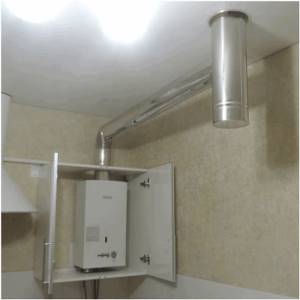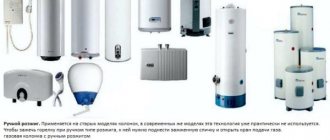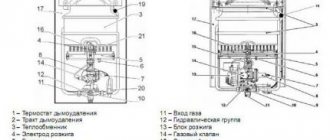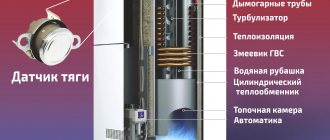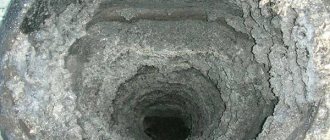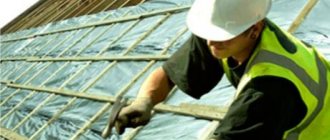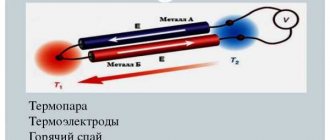Good evening. We have a Bosch wall-mounted gas boiler installed. It has been working for five years. An aluminum corrugation goes from the boiler to the pipe in the ceiling. And recently we had guests, and one friend casually noticed that corrugation cannot be used for a hood. But I don’t feel like calling raygaz and running into trouble. Tell me, is it possible or dangerous?
In some places it is strictly forbidden, in others it is not recommended. My advice is to definitely remove it. Sooner or later, the corrugation burns out, and carbon monoxide begins to flow into the house - an instant death for everyone. Aluminum corrugation is an element of AIR ducts, not chimneys. Replace it with an elbow or tee made of stainless steel or ferrous metal; now there are enough companies that make chimneys to size. Life and health are more valuable than any piece of iron.
Can corrugation be used as a hood for a gas boiler?
Guest wrote: Yes, this corrugation has been standing for years and nothing happens to it! And stainless steel costs 10 times more, you’re just cheating people!
No, we are thinking about your safety and ours. If we install corrugation during installation and something happens, who will be the last one? That's right, we will be responsible. And how many of these corrugations have already been burnt out, when you start dismantling, it falls apart in your hands. The only thing that saved the owners was the presence of draft in the chimneys. So think what is more important - life or wallet, as they say.
Can corrugation be used as a hood for a gas boiler?
It is absolutely not possible if this incomprehensible “corrugation” is intended for air ducts. You need to check in the certificate or other documents for this product whether it can be used to transport media with temperatures above 100 degrees. In addition, the corrugation has increased aerodynamic resistance, which does not have the best effect on traction. If the chimney is not very high (as is often the case in one-story houses with a low ridge), then its gravity may not be enough to ensure normal smoke removal.
Can corrugation be used as a hood for a gas boiler?
Rikota wrote: It is absolutely impossible if this incomprehensible “corrugation” is intended for air ducts. You need to check in the certificate or other documents for this product whether it can be used to transport media with temperatures above 100 degrees. In addition, the corrugation has increased aerodynamic resistance, which does not have the best effect on traction. If the chimney is not very high (as is often the case in one-story houses with a low ridge), then its gravity may not be enough to ensure normal smoke removal.
Rikota, you are wrong! According to the passport, aluminum corrugation can be used at temperatures up to 300C. This is quite enough to remove gases from the gas water heater! Many people have it in their apartments and it hasn’t even lost its original luster! It can be used for speakers. And the diameter must be selected based on the size of the outlet pipe of the column and there will be draft!
Can corrugation be used as a hood for a gas boiler?
Everyone uses aluminum everywhere I go. Just as agreed. A friend of mine had a speaker at home when he was in college, and they often hung out with him. The speaker was old, like NEVA or something, I remember that it turned on with a strong bang. The corrugation of the hood was aluminum and it did not darken at all over time, only a little from dirt, soot and dust. Nobody wants to overpay in short...
You do not have the necessary permissions to view the attachments in this message.
14 Feb 2013, 08:54
Folks, what should I use to make the connection to the hood for the gas water heater? There are stainless steel corrugations on sale, but they are expensive, and there are ventilation corrugations - aluminum. I don’t know if the column exhaust will burn through aluminum, because it melts at a temperature of only 660C. And the flame temperature exceeds 1000C.
14 Feb 2013, 09:10
This is a common misconception. Although the flame temperature is about 1300C, the exhaust temperature drops sharply to 200-300C. This is quite normal, aluminum holds up well. The farther from the gas water heater.
The temperature is of course lower. At the entrance to the ventilation it does not exceed 100C at all.
You do not have the necessary permissions to view the attachments in this message.
Application
Corrugated pipe is used to complete heating appliances that operate on gas, solid and even liquid fuel to remove combustion products. It can be used on almost all boilers, boilers and geysers. The pipe is used for laying external and internal chimneys that have turns and bends - in places where laying a straight, rigid pipe is not possible.
A properly installed and connected boiler or boiler, like any gas water heater, is indispensable in everyday life. Smoke removal using a pipe is one of the most important requirements. A properly installed chimney is the key to your peace of mind.
Is aluminum corrugation suitable for a geyser?
25 Mar 2013, 05:08
Igor_01 wrote: The most important thing here is to maintain the required diameter of the chimney. The smaller it is, the correspondingly higher the wall temperature will be. If you take a 125mm pipe, the temperature will not rise above 150C, but if it is 80C, then it may well float at the connection point.
Aluminum loses strength greatly at temperature; it is not steel.
In general, the diameter of the gas duct should not be taken at the sole discretion of the owner of the device, but strictly correspond to the design, without which gas-using equipment should not be installed.
When designing, the diameter is selected in accordance with the instructions in the passport for the column. Fundamentally, the technical documents for the so-called “corrugation” must indicate the maximum temperature of the environment for which this product is designed. If the temperature is higher (with a margin of at least 30 percent), then you can use it.
The chimney for a gas water heater is usually made in the form of a corrugated metal hose. There is another design - sections of steel pipes, coaxial chimneys. Because of their efficiency, coaxial chimneys have become widespread. The most important characteristics of the system are reliability, long service life, and preservation of its original qualities. A geyser is the optimal solution for hot water supply for houses, as well as for apartments. There will always be hot water, regardless of maintenance and repair work. A chimney is needed to remove combustion products. The dimensions and technical parameters of chimneys depend on the power and type of equipment.
Components of the chimney:
- the upper element is a cone - a protective head (umbrella)
- The next part of the system after the head is the chimney. It can be either with or without thermal insulation.
- the passage pipe provides insulation of the chimney from the wall of the building.
- brackets designed for fastening to the wall of the chimney.
- clamps installed at pipe joints.
- tee for transition from column to pipe.
- inspection window for monitoring the condition of the pipe.
- condensate collector. Condensation is formed as a result of the operation of the entire system.
Things to consider before installing a chimney:
Basic provisions for the chimney of a geyser:
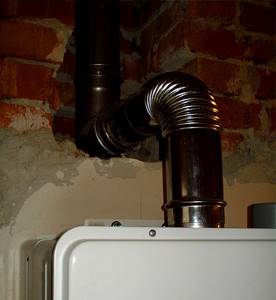
Regulatory requirements
According to the table of definitions NPB 252-98, the exhaust pipe for a gas water heater is the connecting pipe for the smoke exhaust pipe of the device and the smoke duct. Accordingly, it transports gas combustion products and must meet the requirements for chimneys. Failure to comply with them can lead to gas pollution in the room and carbon monoxide poisoning.
All requirements for chimneys are set out in the following regulatory documents:
- NPB 252–98;
- Rules for the production of pipe and furnace works VDPO;
- SP 42-101-2003, Appendix G
- SP 60.13330.2012, which is an updated version of SNiP 41-01-2003 (replacing SNiP 2.04.05–91).
The main provisions that directly relate to smoke removal from household gas water heaters boil down to the following points:
- The cross-sectional area of the exhaust pipe is taken to be no less than the cross-section of the outlet pipe of the unit;
- It is necessary to ensure complete tightness of the chimney, its resistance to corrosion and high temperatures up to 200 °C;
- Laying connecting pipes through living rooms is prohibited;
- The vertical section of the exhaust pipe at the outlet of the column must be 500 mm high, in some cases it can be reduced to 250 mm;
- Connecting pipes should be up to 3 m long in new buildings and up to 6 m in existing ones;
- It is allowed to use no more than 3 turns with a bend radius no less than the diameter;
- The exhaust pipe is installed at a distance from the ceiling or wall made of non-combustible materials of at least 5 cm, if they are combustible or difficult to burn, then at least 25 cm. The distance can be reduced to 10 cm by taking protective measures in accordance with SP 42-101-2003;
- If the connecting pipe for a gas water heater passes through an unheated room, then thermal insulation must be used;
- The exhaust pipe must be laid with a slope of 0.01 or more towards the appliance.
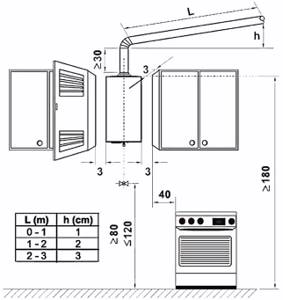
Important! Removal of combustion products is possible only through smoke ducts or specially installed chimneys; the use of ventilation ducts is strictly prohibited.
Smoke ducts are installed in walls made of non-combustible materials and are insulated, if necessary, to prevent condensation. If there are no suitable walls or the building in use does not have channels for removing combustion products, then install a top-type or root-type chimney.
Each fuel-burning device must have a separate smoke duct or pipe. In some cases, it is allowed to remove exhaust gases from the column and boiler into one chimney with an increase in the cross-section of the pipe. In this case, the combustion products must be introduced into the channel at different levels at a distance of at least 0.75 m or at the same level using a cut with a height of 0.75 m and a thickness of 0.12 m.
The chimney must be strictly vertical and have at the base a removable pipe or pocket 250 mm deep with a door for cleaning soot. If it is necessary to bypass existing obstacles, a deviation of up to 30° from the vertical is allowed, while the cross-sectional area is maintained, and the offset should not exceed 1 m.
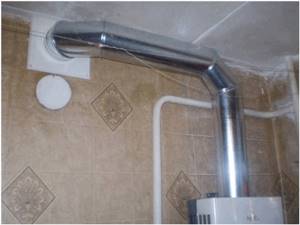
Note: the round or rectangular hole under the entrance to the smoke channel is intended for cleaning soot and must always be accessible for maintenance. When doing general cleaning in the kitchen, do not forget to open the door and clean out soot, leaves and other debris.
The height of the chimney is a key factor in creating good draft. It is this that is decisive in the issue of high-quality removal of combustion products. The height of the chimney must be determined in accordance with the diagram given in SP 42-101-2003 (Appendix D).
If there are taller buildings or trees nearby, then it is necessary to additionally check the height of the wind pressure zone and, if necessary, increase the height of the chimney. In any case, the elevation above the adjacent part of the roof must be at least 50 cm, and with a combined (flat) roof - at least 200 cm.

After installation is completed, the tightness of the smoke exhaust pipe and the presence of draft must be checked. To avoid the risk of loss of draft as a result of freezing of the tip or its blocking by foreign objects, it is prohibited to use nozzles on chimneys in the form of umbrellas, deflectors, etc.
Note: in rooms with hermetically sealed windows, the gas water heater may periodically turn off due to insufficient air flow. The automation stops the operation of the water heater to prevent reverse draft, which may occur due to rarefaction of air in the room. To eliminate the problem, it is enough to keep the kitchen window in micro-ventilation mode while the column is running.
This is interesting: Insulation of heating pipes in the basement
What types of chimneys are there for geysers?
Corrugated chimneys are made from material - laminated multilayer aluminum foil. Along the entire length of the pipe, between layers of aluminum, there is a reinforcing steel wire. The distinctive ability of corrugated foil pipes is the ability to increase their size up to three meters.
The chimney of the geyser is made of steel. Made from high quality steel. Executed in the form of pipe sections. Their length is from one to one and a half meters. On steel chimneys, no more than three bends are allowed. To protect the pipes, they are coated with heat-resistant enamel. The weak point is the need to insulate the pipe in the winter season.
Coaxial chimneys are made of two pipes located one inside the other. Connections are made using special jumpers. Because of them, the pipes do not touch. Street air is supplied to the burner through an external pipe. And the exhaust gases exit through the central one to the outside. Thanks to this design, the street air is heated from the central pipe, increasing the efficiency of the system.
There are two designs of coaxial chimney - horizontal and vertical.
Double-circuit chimney pipes. These chimneys are made from stainless steel. They consist of two pipes, one is inside the other. The inner pipe is separated by thermal insulation made of mineral wool. This has its positive aspects - there are no foreign odors, no condensation forms.
Selection of pipeline material
When going to purchase an exhaust pipe, you need to carefully study the installation conditions, know the model of the gas water heater, the diameter of the smoke exhaust pipe and the required lengths of the pipeline sections. It is advisable to stock up on a diagram of the location of the water heater indicating all the distances; this will help you better navigate when choosing the necessary elements and, if necessary, obtain specialist advice.
According to SP 60.13330.2012, connecting and chimney pipes must be made of non-combustible materials with an equivalent internal surface roughness of no more than 1.0 mm. In addition, they must be tight with tightness class B and prevent air leaks at the connections and in places adjacent to the smoke duct. The use of materials such as ceramics and stainless steel is recommended.
SP 42-101-2003 allows the use of roofing or galvanized steel with a thickness of 1 mm or more, flexible metal corrugated pipes and standardized elements supplied with the unit.
It is very important that the material of the exhaust pipe is resistant to corrosion, since condensation can destroy it quite quickly. The smoother the inner surface, the less soot will accumulate on it. The roughness of the outer surface is not standardized, but from the point of view of ease of cleaning, a smoother material for the connecting pipe will be more practical.
However, corrugated pipes are quite popular for connecting a gas water heater to a smoke duct. They are easy to work with and very convenient in tight spaces. Their use allows you to successfully avoid obstacles and carry out hidden installation, hiding equipment in cabinets and covering the pipeline with removable panels.
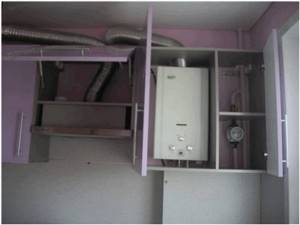
The main disadvantage of corrugated pipes is the possibility of burning out under the influence of high temperatures. Therefore, for fire safety purposes, it is recommended to use stainless steel corrugation rather than cheaper aluminum.
Galvanized steel 1 mm thick is an acceptable material, but there is an opinion that when heated strongly, galvanizing can release harmful substances. Accordingly, its use is undesirable for models with high flue gas temperatures.
Exhaust pipes made of steel coated with heat-resistant enamel have proven themselves quite well. White shiny pipes look quite nice in the kitchen and can fit into almost any interior.
The ideal material in terms of durability, aesthetics and compliance with all requirements is stainless steel. It is not at risk of corrosion, burnout, dust accumulation, or accidental damage. Quite naturally it turns out to be the most expensive.
